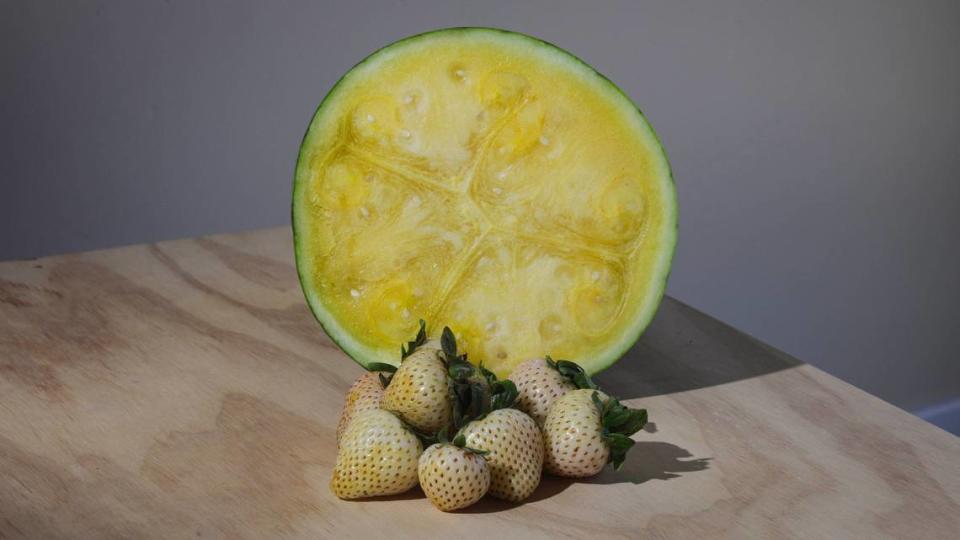White strawberries, yellow watermelon, pink pineapple. Are freaky fruits a new status symbol? | Opinion
Imagine a strawberry shortcake.
Start with the base — a biscuit or maybe a slice of pound cake. Now add a generous mound of ripe red berries. Maybe pop in a few blueberries for color. Cover the berries with whipped cream — the kind that comes in a carton, not a can. Lastly, lovingly place one perfectly formed, unblemished berry on top.
Got it in your mind’s eye?
OK. Now replace those bright red strawberries with white ones.
Weird, right? Doesn’t exactly scream Fourth of July.
And yet, white strawberries are sort of becoming a thing. Not a big thing, but they are showing up at fruit stands and farmers markets and boutique grocery stores.
Oceano, a small community on the Central Coast known for its strawberries, is one place you can find them. They are locally grown by the Hayashi family, which has been raising fruits and vegetables on the Central Coast for decades.
The family has quietly added white strawberries — tinged with a pale pink — to their more traditional inventory at the popular Hayashi Fruit Stand.
“They’ve been something to try in the last few years,” said Alan Hayashi. “It’s just another fruit to market, to see if there’s a place for it.”
And how about that yellow watermelon?
It’s not just white strawberries. If you’ve done much shopping lately — especially at higher-end markets — you may have come across watermelons with yellow flesh or honeydews that are the usual creamy white on the outside but orange on the inside.

Or maybe you’ve read about genetically engineered pink pineapples that can be shipped to your door.
Yes, they are expensive. Pink pineapples from Costa Rica, for example, cost $29 or more. Apiece.
Other exotics can be costly too, since they tend to be finicky to grow and may not yield as much as the more common varieties.
In that sense, “off-color” fruits are a luxury — a status symbol, if you will, like a Louis Vuitton handbag.
They’ve been ‘around forever’
These fruits may be a fad, but they aren’t new.
Yellow-flesh watermelons predate red watermelons; they were cultivated in Africa 5,000 years ago. The red melon was produced through selective breeding.
Yellow watermelon, by the way, is common in other parts of the country, but it’s not something we see everyday in California. At least not yet.
White strawberries also “have been around forever,” said Gerald Holmes, the director of the Cal Poly Strawberry Center.
“I don’t think anything new is happening,” he said, “Except for marketing. People are really into their food these days and they love seeing variety.”
‘We all kind of buy with our eyes’
The most expensive fruits have been marketed almost exclusively to foodies, but some varieties are becoming more widely available — and cheaper.
Trader Joe’s has sold yellow watermelon at prices comparable to red watermelon. Hayashi Fruit Stand sells white strawberries for $5 a carton — only $1 more than the red ones.
Still, putting uncommon fruits in front of consumers — even at reasonable prices — doesn’t guarantee sales.
“We all kind of buy with our eyes,” Hayashi said. “Unless they’re willing to try something new, I would say the majority of people won’t even try them.”
When he’s working at the family fruit stand or a farmers market, Hayashi invites people to sample his white strawberries.
“I like watching the looks on their faces,” he said. “That shock value is eye-opening.”
Color sends a message to our brains
Compared to, say, yellow-flesh watermelon, which has the usual green rind on the outside, white strawberries look especially weird.
“Their seeds called to mind clogged pores in need of a nose strip,” described Yasmin Tayag, a staff writer for The Atlantic who stumbled across them at a supermarket.
I get it. I grew up on red strawberries and at first glance, the white ones looked pathetically anemic to me, like seriously under-ripe fruit. The taste — which has been variously described as having hints of pineapple or peach — didn’t seem any different from red strawberries.
“Meh” was my overall reaction, but that may not have been the fruit’s fault.
Psychology plays a role in how we respond to food. Whether we realize it or not, the color of food sends a message to our brains.
“People make assumptions about what their food will taste like using color,” writes Ken Phillips, a marketing expert with HunterLab. “They may believe that a bright red apple will taste sweet, for example. If the real flavor of the food fails to meet expectations, the brain may not perceive the difference, replacing existing tastes with expected flavors or elevating tastes that are milder than anticipated.”
Color me skeptical. If that were truly the case — if our brains tricked us into thinking a bland Red Delicious apple was actually packed with flavor— there would be no bad apples.
Still, it does make sense that white strawberries would mess with our brains, which have been programmed to believe that strawberries must be red to be ripe.
But I may give the oddball berries another try. Not for strawberry shortcake, but maybe in a fruit salad, along with some big chunks of that weird-looking yellow watermelon.


